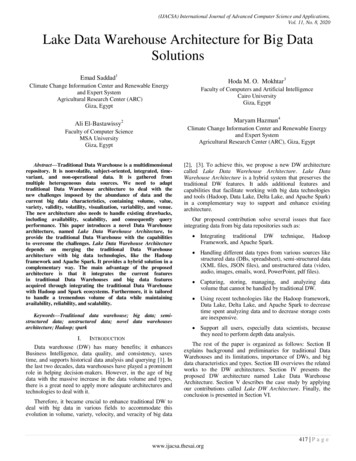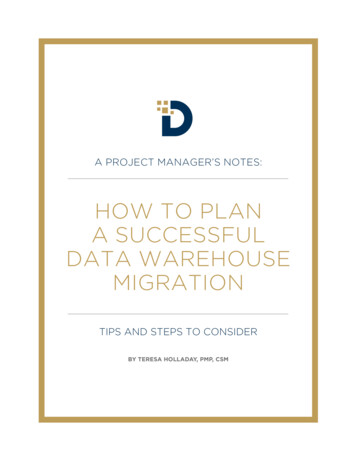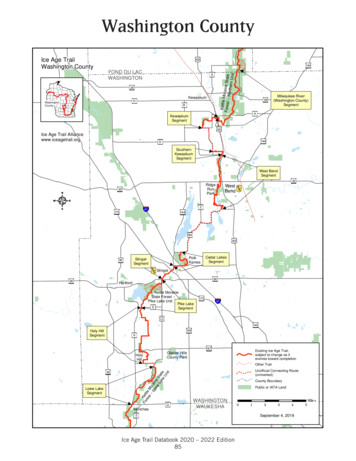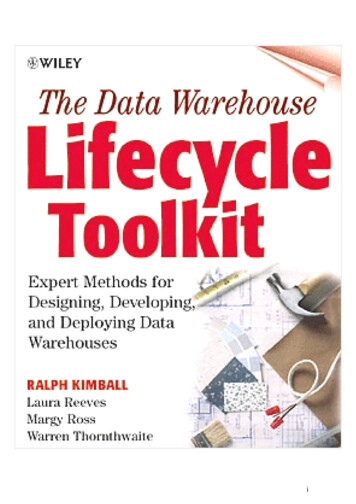
Transcription
(IJACSA) International Journal of Advanced Computer Science and Applications,Vol. 11, No. 8, 2020Lake Data Warehouse Architecture for Big DataSolutionsEmad Saddad1Climate Change Information Center and Renewable Energyand Expert System Agricultural Research Center (ARC) Giza, EgyptHoda M. O. Mokhtar3Faculty of Computers and Artificial IntelligenceCairo UniversityGiza, EgyptMaryam Hazman4Ali El-Bastawissy2Climate Change Information Center and Renewable Energyand Expert SystemAgricultural Research Center (ARC), Giza, EgyptFaculty of Computer ScienceMSA UniversityGiza, EgyptAbstract—Traditional Data Warehouse is a multidimensionalrepository. It is nonvolatile, subject-oriented, integrated, timevariant, and non- operational data. It is gathered frommultiple heterogeneous data sources. We need to adapttraditional Data Warehouse architecture to deal with thenew challenges imposed by the abundance of data and thecurrent big data characteristics, containing volume, value,variety, validity, volatility, visualization, variability, and venue.The new architecture also needs to handle existing drawbacks,including availability, scalability, and consequently queryperformance. This paper introduces a novel Data Warehousearchitecture, named Lake Data Warehouse Architecture, toprovide the traditional Data Warehouse with the capabilitiesto overcome the challenges. Lake Data Warehouse Architecturedepends on merging the traditional Data Warehousearchitecture with big data technologies, like the Hadoopframework and Apache Spark. It provides a hybrid solution in acomplementary way. The main advantage of the proposedarchitecture is that it integrates the current featuresin traditional Data Warehouses and big data featuresacquired through integrating the traditional Data Warehousewith Hadoop and Spark ecosystems. Furthermore, it is tailoredto handle a tremendous volume of data while maintainingavailability, reliability, and scalability. Keywords—Traditional data warehouse; big data; semistructured data; unstructured data; novel data warehousesarchitecture; Hadoop; sparkI. INTRODUCTIONData warehouse (DW) has many benefits; it enhancesBusiness Intelligence, data quality, and consistency, savestime, and supports historical data analysis and querying [1]. Inthe last two decades, data warehouses have played a prominentrole in helping decision-makers. However, in the age of bigdata with the massive increase in the data volume and types,there is a great need to apply more adequate architectures andtechnologies to deal with it.[2], [3]. To achieve this, we propose a new DW architecturecalled Lake Data Warehouse Architecture. Lake DataWarehouse Architecture is a hybrid system that preserves thetraditional DW features. It adds additional features andcapabilities that facilitate working with big data technologiesand tools (Hadoop, Data Lake, Delta Lake, and Apache Spark)in a complementary way to support and enhance existingarchitecture.Our proposed contribution solve several issues that faceintegrating data from big data repositories such as: Integrating traditional DW technique,Framework, and Apache Spark. Hadoop Handling different data types from various sources likestructured data (DBs, spreadsheet), semi-structured data(XML files, JSON files), and unstructured data (video,audio, images, emails, word, PowerPoint, pdf files). Capturing, storing, managing, and analyzing datavolume that cannot be handled by traditional DW. Using recent technologies like the Hadoop framework,Data Lake, Delta Lake, and Apache Spark to decreasetime spent analyzing data and to decrease storage costsare inexpensive. Support all users, especially data scientists, becausethey need to perform depth data analysis. The rest of the paper is organized as follows: Section IIexplains background and preliminaries for traditional DataWarehouses and its limitations, importance of DWs, and bigdata characteristics and types. Section III overviews the relatedworks to the DW architectures. Section IV presents theproposed DW architecture named Lake Data WarehouseArchitecture. Section V describes the case study by applyingour contributions called Lake DW Architecture. Finally, theconclusion is presented in Section VI.Therefore, it became crucial to enhance traditional DW todeal with big data in various fields to accommodate thisevolution in volume, variety, velocity, and veracity of big data417 P a g ewww.ijacsa.thesai.org
(IJACSA) International Journal of Advanced Computer Science and Applications,Vol. 11, No. 8, 2020II. BACKGROUND AND PRELIMINARIESIn this section, we will review the background of relatedtopics, such as traditional DWs, its limitations, and why weneed to redevelop it. Moreover, we will discuss variousrelated technologies. Managing customer expectations.A. Traditional Data Warehouses(DWs)Traditional DWs are integrated, a subject-oriented,nonvolatile, and time-variant data to support decision-makers[4], as presented in Fig. 1. Those four properties differentiateDWs from other data repository systems, such as relationaldatabase systems [5]. Handling product existence and status. Meeting growth of the business. Using advancesimprovements.in Improving tscompetitive Decreasing operational and financial risks. Evaluating and forecasting trends and behaviors.D. The Age of Big dataBig Data is a data volume that is available in differentlevels of complication. It is generated at various velocities andlevels of uncertainty; hence it is not handled using traditionalapproaches, traditional technologies, or traditional algorithms[6]. Today, big data is characterized byten maincharacteristics namely volume, variety, velocity, veracity,value, validity, variability, visualization, volatility, and venue[3], [10], [2], [11], [12], [13] as follows:Fig. 1. Traditional Data Warehouses (DWs) architectureUsually, in primary DW, there are data marts (DMs). Datamarts (DMs) are a small DW that contains only a subset of dataobtained from a central DW. The content of DMs representsinformation from a specific domain of interest. Many DWsservers are used to manage data. These servers presentmultidimensional views of data to a variety of front-end tools.B. The limitations of Traditional DW ArchitectureIn [6], [7], and [8], the authors reviewed some limitationsof DW, such as supporting only structured data, on thecontrary, do not support semi-structured data, or unstructureddata. In addition to the above, the restriction of handling datavolume in terabytes, which does not scale to petabyte size, iswidely available. Besides, it is costly as it depends onproprietary hardware and software.Moreover, traditional DW performs analytic queries, whichconsequently affects the whole query performance, accessing,and processing of data. The decision-making process also maybe affected if: 1) the correct data are not available at a suitabletime, and 2) the growth of the business requires new methodsfor data management other than adapting traditional DWarchitecture.C. The Objectives of the redeveloped traditional DWOne of our main objectives is to overcome the limitationsof traditional DW architecture built on outdated technologies[4]. We initiate an overall architecture that supports thefunctionalities of the traditional DW with abilities to include[6], [9] : Meeting new business requirements. Depending on lower-cost infrastructure. Handling heterogeneous data and new data structuresand formats. Volume: the huge amount of data generatedcontinuously on an hourly or a daily basis fromdifferent sources. Such as terabytes generated per hourfor applications like YouTube, Instagram, and Google. Variety: the types of big data that are ingested fromdifferent data sources. Velocity: the speed at which data is produced. Theaspects of data may be batch data or streaming data. Veracity: the quality of data that is being handled toobtain valuable insights. Such as ambiguous,inconsistent, incomplete, anomaly, uncertain, andbiased data. Value: represents the business value to be derived frombig data. Validity: refers to the correctness of data used to extractoutputs in the form of information. Variability: refers to the inconsistent data flow. Visualization: refers to the ability to analyze and visualinsights as an output of big data analysis. Volatility: the stored data on how long it is valuable tothe consumer. Venue: refers to a various platform where numerouskinds of data from different sources byseveral platforms. In general, data are a set of qualitative values orquantitative variables; Big Data can be categorized into threetypes [2], [9]: Structured data. The data has a defined structure or aschema organized either in the form of a relationaldatabase or in some other way that is easy to operate.For example, data stored in a relational database (in the418 P a g ewww.ijacsa.thesai.org
(IJACSA) International Journal of Advanced Computer Science and Applications,Vol. 11, No. 8, 2020form rows and columns), in spreadsheets (such as CSVfiles), and cleansed data (that have been processed witha lot of cleansing and filtering). Semi-Structured Data: The data is hard to retrieve,analyze, and store as structured data. It requires a bigdata software framework (such as Apache Hadoop) toachieve these operations. For example, XML files,JSON files, and BibTex files. Unstructured Data: The fully unorganized data isdifficult to handle, and it requires advanced softwareand tools to access it. Examples include video, audio,images, emails, word, PowerPoint, pdf files, webpages,location coordinates, and streaming data.E. Hadoop Framework and Data LakeHadoop is an open-source software framework. It allowsthe execution of the MapReduce processes for data processing.It provides massive storage for all data types, massivelyparallel processing, and storing data and running applicationson clusters to accomplish better computation resources [14].Hadoop has main components as follows [15], [16], [17]: The Hadoop Distributed File System (HDFS) is a filesystem, which manages storage and access to dataspread across the different nodes of a Hadoop cluster. YARN is a Hadoop cluster resource manager used toassign system resources for applications and scheduleof the jobs. Map-Reduce is a processing engine and a programmingframework used to manage large-scale batch data in theHadoop system. Hadoop Common is a set of services and institutionsthat provide underlying capabilities needed by the otherparts of Hadoop. Data Lake is a data store that can collect any type of data:structured, semi-structured, or unstructured data, which arestored with one another regardless of structure, format, or types[18], [19]. It is a conceptual idea that is usually implementedwith one or more technologies such as Hadoop and NoSQLdatabases. When querying the Data Lake, only need data willtransform that are relevant to business needs [20].Creating Data Lake depends on Hadoop's technology,which is a component (as the platform) for the data lake. It isthe complementary relationship between Data Lake andHadoop [21], [22], [23]Data Lake is similar to traditional DW in that they are bothrepositories for data. However, there are apparent differencesin features between them [7]—the schema on reading in DataLake, but schema on write in DW. The scale of data in DataLake is enormous, while it is large data volumes in DW. Thedata sources may be semi-structured data or/and unstructureddata, but it is mainly structured data in DW [24], [25], [26],[27].F. Apache Spark and Delta LakeApache Spark is an open-source applied for big dataanalytics and distributed systems. It provides streaminglibraries, SQL, graph analysis, and machine learning. It has twomain components Spark streaming, which is used for managingreal-time data, and the Spark engine , which directly processeseach data chunks by Spark streaming [28], [29], [30].Delta Lake is an open-source Spark storage layer. It is anextra storage layer that makes reliability to our data lakes builton The Hadoop Distributed File System (HDFS) and cloudstorage [31]. Delta Lake provides a series of other featuresincluding: Joining streaming and batch data processing. Giving a scalable metadata approach. Providing ACID transactions that guaranteedconsistency of the data stored inside the data lakethrough ensuring that only complete writes arecommitted. Time travel that is allowing one to access and returnprevious versions of the data. Schema evolution as data evolves, Delta allowsSpark table to change in the schema and many morewhile we use Delta. Enabling a Data Lake to update data without goingthrough the entire Data Lake repository .III. RELATED WORKSSeveral efforts have been conducted to adapt traditionalDWs for handling new user requirements and changes in theunderlying data sources . Many approaches focus on DWs thatdeal with a relational database. However, they cannot beappropriated to deal with big data. In [32], somemethodologies try to solve the problem by developingthe ETL (Extracting, Transforming, and Loading) process. In[33], the authors attempt to update DW Schema to reflectmodifications that already took place. As mentioned in [33],[33], [34], [5], [35], [36] , the authors use temporal DWand schema versions to update the DWs Structure by keepingmore than one DWs version. These works do not depict howthe user's needs impact the evolution changes. Limited approaches have taken care of handling the aspectof big data development. The approach mentioned in [37]describes data schema specification and evolution processing,but it does not depend on DW. The work presented in [38]explained the method for treating the growth of thedata sources in the integration area using big data integrationontology. It can handle some changes in data sources, but itdoes not determine how to answer all requirements. Several types of research have concentrated on the use ofDWs in big data analysis. The authors in [39] display anOLAP method for big data executed with Hadoop. They focuson multidimensional analysis for big data analysis. However,they do not address big data evolution, which applies to theresearch work proposed in [40] and [26].419 P a g ewww.ijacsa.thesai.org
(IJACSA) International Journal of Advanced Computer Science and Applications,Vol. 11, No. 8, 2020Other researchers studied the problem of big data evolution.In [41], the authors discuss a methodology for constructing asystem for big data analysis. However, it cannot be applicablein the state of the previously used data is not provided. The authors in [42] presented the DW approach for BigData analysis that was implemented using Map-Reduce. Thisapproach handles two types of changes: (1) schema versions inmetadata control variations of the fact table and (2) slowlychanging dimensions. The approach does not process changesin big data sources that may affect the analysis processand results.IV.THE PROPOSED LAKE DATA WAREHOUSEARCHITECTUREOur contribution aims to adapt traditional DW to solve thenew challenges by handling semi-structured and unstructureddata. In addition to managing the growth of businessrequirements and treating the two main drawbacks, namely,availability and system performance. Furthermore, it enhancesquery performance by providing the required data from users atany time.In this section, we present a novel DW architecture thatimproves the traditional DW performance to deal with thesechallenges. Our contribution integrates the traditional DWarchitecture with big data technologies like Hadoop andApache Spark.In the age of big data, We need to improve DW architectureto handle the new challenges imposed by big data. The HadoopFramework and Apache Spark are a complement to handlingthe challenges of traditional DW; each has its advantages indifferent circumstances. In some cases, we need the HadoopFramework and Apache Spark to process unstructured or semistructured data (raw data) and large volume datasets (big data).In other words, we still depend on traditional DW forconsistent and high-quality data (structured data), and lowlatency and interactive reports.In Fig. 2, we explain the proposed Lake DW Architecture.Where Hadoop and Spark do not replace traditional DW andBig Data is going to change traditional DW architecture but notreplacing it. Our contribution depends on integrating traditionalDW techniques, Hadoop Framework, and Apache Spark into ahybrid solution.The large amount of big data generated every minute andevery hour needs a data lake that can scale to handle thisvolume. Therefore, we use Hadoop as a data platform for datalakes to provide extensive scalability at an acceptable cost.Besides, Data Lakes can be complemented DW besides theHadoop framework. Also, Data Lakes can be complementedDW besides the Hadoop framework. Our proposed architecturedifferentiates itself from all previous work. It is ahybrid environment that upgrades traditional DW with Hadoopenvironment depending on the Hadoop- based Data Lakebecause it can extend the use and capabilities of traditionalDW, as follows: Collecting or capturing data from structured datasources using ETL Architecture. DW depends on thetraditional ETL process; where extract (E) data fromoperational databases and then, the data process, cleanand transform (T) before loading (L) them into the DWor data marts or virtual data marts. DW is designed tohandle and analyze read-heavy workloads. DW needs todefine the data model before loading the data. Then,they call a Schema-On-Write approach, as presented inFig. 2. Collecting or capturing data from Semi-Structured orUnstructured data sources using ELT Architecture. BigData requires a different process to collect data wheretraditional ETL does not work well on semi-Structure orunstructured data. Big Data calls for ELT. The raw datawill be stored in its original format. The preprocessingstep will not be used until the query or other applicationacknowledge/ ask for these data. Where Data Lake isdifferent from DW through the processing of data in theELT order and utilizing the Schema-on-Read approach,as shown in Fig. 2.Fig. 2 presents a set of essential components of ourcontribution model as follows:A. Hadoop-Based Data Lake architecture in CloudEnvironmentIt is using Hadoop as a staging area for DW by addingHadoop-based Data Lake that is a storage repository that isused for complementing traditional DW. It is using as a datasource that passes only required data to Data Lake andingesting unlimited amounts of raw data that related tobusiness objectives. As shown in Fig. 2, we explore theHadoop-based Data Lake architecture has many layers asfollows:1) Ingesting data layer: ingests raw data in native format,where the ingested data can be micro-batch, macro-batch,batch, real-time, or hybrid.2) Landing data layer: Different data types (ingested inthe previous layer) are stored in native format (withoutprocessing). In this layer, users can find the original dataversions of their analysis to aid the subsequent handling.Fig. 2. The proposed Lake Data Warehouse (DW) Architecture 3) Metadata Layer: is responsible for making data easy toaccess and extract values from Data Lake. It helps to make420 P a g ewww.ijacsa.thesai.org
(IJACSA) International Journal of Advanced Computer Science and Applications,Vol. 11, No. 8, 2020identifications, data versioning, entity and attributes,distributions, quality.4) Governance Data Layer: applies to the other layers. Itis responsible for authentications, data access, data security,data quality, and data life cycle. It determines theresponsibilities of governing the right to access and handlingthe data.B. Delta Lake architecture with Apache Spark CloudEnvironmentDelta Lake technology is used with Apache Spark toimplement our proposed model by creating a cloud dataplatform for solving Data Lake challenges, such )1) the dataquality is low, )2) reading and writing are not guaranteed, )3)insufficient performance with growing volumes of data, and )4)updating records is hard [43]. As presented in Fig. 2, DeltaLake Architecture has two layers:1) The atomic layer would be a Silver Delta table builtusing Object Storage, and2) The Departmental layer would be any number of GoldDelta tables also built on Object Storage. We employ Sparkand store all data in Apache Parquet format allowing DeltaLake to leverage the well-organized compression native toParquet.Apache Spark is used to read and process huge files anddatasets. Spark provides a query engine capable of processingdata in huge data files. Some of the most significant Spark jobsin the world run on Petabytes of data. Apache Parquet has theformat as a columnar file responsible for optimizations to gofaster queries [44]. It is a more efficient file format than JSONfiles. It is suitable for data processing in the Hadoop. Itprovides an efficient method to handle complex datasets.The main difference between our contributions Lake DWArchitecture over traditional DW as follows: Handling different data types (structured, semistructured, and unstructured data) from various sources. Extracting, storing, managing, and analyzing datavolume that cannot handle by traditional DW. Integrating between traditional DW technique, HadoopFramework, and Apache Spark as a hybrid solution. Ituses ETL or ELT processes depending on types of datasources.collect and process the Internet of Things (IoT) data.We provide a demo IoT sensor dataset for demonstrationpurposes. The data simulates heart rate data measuredby health tracker devices. Each file consists of five users whoseheart rate is measured each hour, 24 hours a day, everyday. We store datasets in the data lake as JSON files. We usetwo data files in JSON format, the first file for readingsrecordedbythedevicesinJanuary2020(health tracker data 2020 01.json), and the second file forthe readings recorded by the devices for February 2020(health tracker data 2020 02.json).We implemented on Data Lake, Delta Lake, and ApacheSpark in Databricks, which provides an integrated platform forworking with Apache Spark. When working with Delta Lake,Parquet files can be converted in-place to Delta files. Next, wewill convert the Parquet-based data lake table we createdpreviously into a Delta table.A. Configure Apache Spark1) CreatingtheClustreHelthTracherclusteriscomputation resources used to run data science and dataanalytics such as the ETL process, ad-hoc analytics, andstreaming analytics.2) Configuration the Apache Spark, we will need toperform a few configuration operations on the Apache Sparksession to get optimal performance. These will includecreating a database to store data, as shown in the followingSpark SQL script:3) In additional to configure the number of shufflepartitions as shown in the following Spark SQL script:B. Importing data from a Data Lake into a Delta Lake byETL of Apache SparkWe import data from our Data Lake and save it into a DeltaLake as Parquet files. We appended the first month of recordsand kept in the health tracker data 2020 02.json file byusing the ETL process of Apache Spark. In additional toconfigure the number of shuffle partitions as presented in thefollowing Python language scripts: Supporting different data types in various sources. Determining and analyzing data from Data Lake andDelta Lake, they scale to extreme data volumes. Supporting all users, especially Data scientists, becausethey can do in-depth analysis.V. CASE STUDYOur goal of this section is to experiment with ourcontribution to prove its effectiveness in dealing with big dataand analyze it for decision-makers. This case study shows howour proposed model can extract, integrate, and analyze big datathat cannot be handled by traditional DW. We use Data Lake to421 P a g ewww.ijacsa.thesai.org
(IJACSA) International Journal of Advanced Computer Science and Applications,Vol. 11, No. 8, 2020In Fig. 3, we visualize the sensor data over time, asdisplayed in the following Spark SQL script:2) Register the Delta Table: we will register the table inthe Metastore. The Spark SQL command will automaticallyinfer the data schema by reading the Delta files' footers, asshown in the following Spark SQL script: Fig. 3. The sensor data over time.C. Create a Parquet-based Data Lake TableWe convert the existing Parquet file to The Parquet-baseddata lake table that will be used to Delta tables. We will bewriting files to the root location of the Databricks File System(DBFS) in our cloud object storage. We create the table usingthe Create Table As Select (CTAS) Spark SQL pattern asshown in the following script:With Delta Lake, the Delta table is ready to use thetransaction log stored with the Delta files containing allmetadata needed for an immediate query. We count the recordsin the health tracker silver table with a Spark SQL query asfollows:E. Creating an aggregate Delta Table: The Departmentallayer of Delta LakeWe create a new Delta table (an aggregate table) from thedata in the health track silver Delta table. We create ahealth tracker user analytics Delta table of summarystatistics for each device. We use the Create Table As Select(CTAS) Spark SQL as shown in the following script: Count the records in the health tracker silver table. Weexpect to have 3720 records: five device measurements, 24hours a day for 31 days, as shown in the following Spark SQLscript:D. Convert an Existing Parquet-based Data Lake Table to aDelta table: The Atomic layer of Delta LakeA Delta table consists of three things: (1) The Delta filescontaining the data and kept in object storage. (2) A Delta tableregistered in a central Hive meta-store accessible by all clustersto persist table metadata. (3) The Delta Transaction Log (anordered record of every transaction) saved with the Delta filesin object storage. To Convert an Existing Parquet-based DataLake Table to a Delta table by using the following steps:F. Exploring analysis resultsThe health tracker user analytics table could be usedto define a dashboard for analyzing of the results according tobusiness requirements as provided in Fig. 4 which describesthe aggregation results such as maximum, minimum, andaverage data, as presented in the following Spark SQL script: 1) Convert the Files to Delta Files: We convert the filesin place to Parquet files. The conversion creates a Delta Laketransaction log that tracks the files. Now, the directory is adirectory of Delta files, as shown in the following Spark SQLscript: Fig. 4. The analysis of the results according to business requirements.422 P a g ewww.ijacsa.thesai.org
(IJACSA) International Journal of Advanced Computer Science and Applications,Vol. 11, No. 8, 2020G. Appending Files to an Existing Delta Table (Batch datawrite to Delta Tables)We convert the existing Parquet file to The Parquet-baseddata lake table that will be used to Delta tables. We will bewriting files to the root location of the Databricks File System(DBFS) in our cloud object storage. We create the table usingthe Create Table As Select (CTAS) Spark SQL pattern asshown in the following script:H. Exploring analysis resultsWe can modify existing Delta tables through appendingfiles to an existing directory of Delta files. We append the nextmonth of records, kept in the health tracker data 2020 02table by using the INSERT INTO Spark SQL command asshown in the following script:Fig. 5. The absence of records.K. Identify Broken Readings in the TableIn the initial load of data into the health tracker silvertable, we noted that there are broken records in the data. Inspecific, we made a note of the fact that several negativereadings were present even though it is impossible to record anegative heart rate. Let us assess the extent of these brokenreadings in our table. First, we create a temporary view for thebroken readings in the health tracker silver table, as shown inthe following Spark SQL script: I. Assessing the Missing RecordsAfter a batch update of the health tracker silver table, wecounted the number of records in the table. We discovered thatsome records were missing by Count the Number of Recordsper Device.Next, we sum the records in the view, as shown in thefollowing Spark SQL query:J. Assessing the Missing RecordsAfter a batch update of the health tracker silver table, wecounted the number of records in the table. We discovered thatsome records were missing by Count the Number of Recordsper Device. TABLE I.THE NUMBER OF RECORDS PER DEVICEDevice IDNumber of Records0144011440214403144041345In Table I, device number 4 looks are missing 95 records.We run a query to discover the missing records' timing bydisplaying the number of records per day. We have no recordsfor device 4 for the last few days of the month, as shown in thefollowing Spark SQL query: SELECT dte as Date, p device id as Device Id,heartrate as Heart Rate ReadingFROM health tracker silverWHERE p device id IN (1, 4) and dte "20-2-2020"In Fig. 5, the absence of records from the last few days ofthe month shows a phenomenon that may often occur in aproduction data pipeline: late-arriving data. Delta Lake allowsus to process data as it arrives and is prepared to handle theoccurrence of late-arriving data.SELECT SUM(broken readings count)FROM broken readingsResult: 67VI.CONCLUSIONMany companies use DWs in different areas to help in thedecision-making process. Besides, DWs enhance businessintelligence, data quality, and consistency, saving time,and storing historical data. In the age of Big Data, the amountof data needed for ingesting and storing is an unprecedentedrate. However, the architecture of the traditional DWscannot manage such large amounts of data. Its new types fromthe current data sources are autonomous, heterogeneous,scalable, and distributed, which requires modern tech
Lake Data Warehouse Architecture for Big Data . PowerPoint, pdf files, webpages, location coordinates, and streaming data. E. Hadoop Framework and Data Lake Hadoop is an ope










